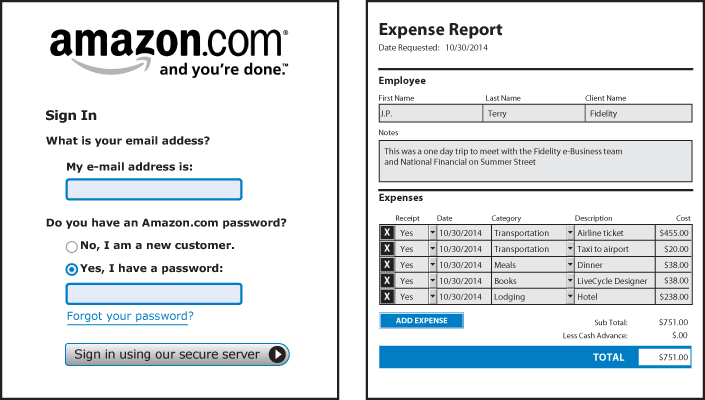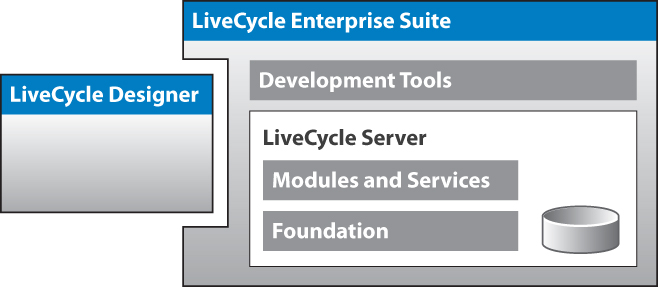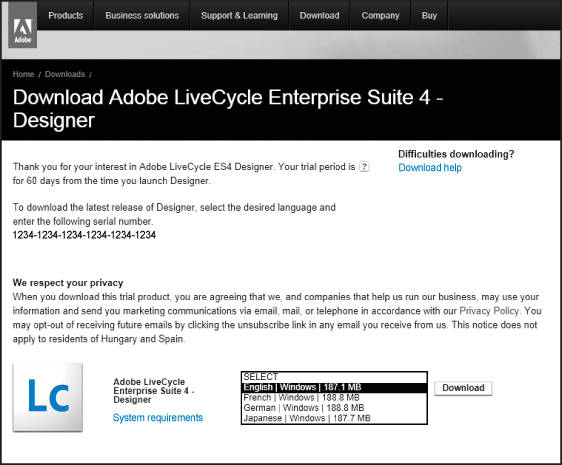Introduction
Did you fill out a form to purchase this book?
If not, are you going to fill out a form to expense it to your company?
In the information age, the primary way that we provide information to computer systems is through forms. Computers can communicate with each other easily. However, when we need to provide information to a computer system, we have to fill out some type of form (Figure I.1).
Forms are everywhere today. We’re presented with forms when a system or an organization wants some type of information from us. For example, the government uses forms to ask us for income information for tax purposes; youth soccer teams use forms to ask us about our children’s health before the start of the season. And with the rise of e-commerce, we’re seeing an increase in interactive forms for opening accounts and for purchasing products and services. Paper forms and online forms are part of our daily lives in the information age.
It’s interesting to note that computers don’t need forms as we think of them. Most computer programs require data in much smaller and simpler structures. The graphic and layout elements in our forms like rules; shapes and images are usually disregarded by the computers that process them. For instance, in a typical address change, the most pertinent information for the computer to know can be contained within a simple and compact file like this one:
<addressChange>
<individual>
<firstName>James</firstName>
<lastName>Shannon</lastName>
<oldAddress>
<address>1 Main Street</address>
<city>Springfield</city>
<state>IL</state>
<zipCode>62701</zipCode>
</oldAddress>
<newAddress>
<address>101 Main Street</address>
<city>Springfield</city>
<state>IL</state>
<zipCode>62701</zipCode>
</newAddress>
</individual>
</addressChange>
People are the ones who need clearly designed forms (Figure I.2). We need a graphically clear presentation of data to understand it and process it. We need to comprehend the context of the information exchange. We don’t want to simply provide and access data. We want to know why we’re providing data and what benefits we’re deriving from our data provision. Forms should be designed for us and be human compatible.
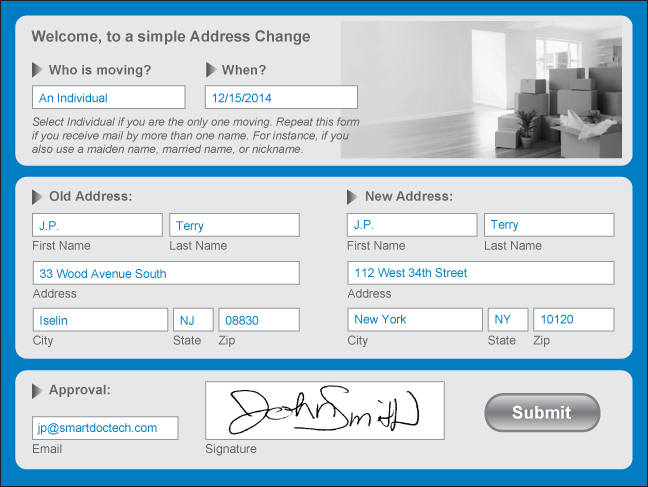
Figure I.2 A well-designed form helps users understand the required information and how to supply it to complete the transaction.
The trouble is that too many forms are difficult to use and fill out properly. According to a survey by Compete Inc., over 70 percent of online account opening forms are abandoned before completion. The cost to business in lost opportunity and increased customer call center traffic is so substantial that it requires us to make a renewed effort to create engaging and effective forms.
If only there were a program with features and tools to help us create engaging and effective forms and link them with data. It would be even better if this program were developed and supported by the unquestioned worldwide leader in graphics software. Well, your dreams have come true, and it gets even better.
Adobe LiveCycle Designer, the premier form development tool for the last l0 years, can now create HTML forms as well as PDF forms. The same LiveCycle Designer source files can be used for both. You can create your interactive and dynamic fully featured forms and deploy them as HTML forms to mobile devices like the Apple iPad and Google Android tablets.
Adobe LiveCycle Designer
LiveCycle Designer (Designer for short) is a Microsoft Windows–based program that provides all the tools you need to create basic or sophisticated forms. You can use Designer in either of the following ways:
![]() As a standalone program to create forms and documents
As a standalone program to create forms and documents
![]() As part of Adobe LiveCycle Enterprise Suite (Figure I.3)
As part of Adobe LiveCycle Enterprise Suite (Figure I.3)
LiveCycle Enterprise Suite consists of additional development tools and a LiveCycle Server. You’ll learn more about LiveCycle Enterprise Suite in Chapter 9. When it’s relevant, I’ll mention server tools and features and refer to them simply as “LiveCycle Server” to differentiate them from LiveCycle Designer.
However, the focus of this book is Designer. You’ll learn all about Designer’s tools and how you can use them to create and manage interactive forms and dynamic documents. There are many step-by-step exercises so you can get hands-on and learn the best practices for creating PDF and HTML forms. After you learn the techniques, the last part of this book will show you how your Designer documents are used in the real world to automate business.
Who This Book Is For
This book is designed for people who want effective and efficient customer engagement with their form systems. You may want to create a new form system or improve an existing one. In either case, the following types of professionals will benefit from this book.
Form Developers
Whether you are new to Designer or you’re a seasoned professional, you’ll find valuable information and examples in these pages to help you with your craft. As you probably know, today’s form developers need to be multi-talented, and this book will help you in these areas:
![]() Developing your graphic layout and data pattern skills to meet form requirements
Developing your graphic layout and data pattern skills to meet form requirements
![]() Developing new advanced scripting skills for form automation
Developing new advanced scripting skills for form automation
![]() Understanding how your forms fit into your workflow automation
Understanding how your forms fit into your workflow automation
![]() Understanding the new world of mobile forms
Understanding the new world of mobile forms
Programmers and IT Professionals
Forms and documents provide the input and output for the computer systems you create and manage. Many of your data goals, including validation and formatting, can be accomplished with well-designed interactive forms. This book will show you how to
![]() Take advantage of Designer’s out-of-the box tools and features to improve your systems right away.
Take advantage of Designer’s out-of-the box tools and features to improve your systems right away.
![]() Enhance Designer’s standard tools with custom scripting.
Enhance Designer’s standard tools with custom scripting.
![]() Integrate Designer’s forms and documents into your existing enterprise systems, including databases, workflow tools, websites, and document management systems.
Integrate Designer’s forms and documents into your existing enterprise systems, including databases, workflow tools, websites, and document management systems.
Business Professionals
Business has changed greatly in the last 20 years. B2C (business-to-consumer) and B2B (business-to-business) e-commerce is an increasingly important aspect of your job. This book will show you how effective forms and workflow automation will help you deliver the following:
![]() Improved customer engagement with your forms and electronic communications
Improved customer engagement with your forms and electronic communications
![]() Greater conversion of prospects into customers by simplifying the data-gathering process
Greater conversion of prospects into customers by simplifying the data-gathering process
![]() Fewer costs and greater speed by converting previously paper-based processes to electronic workflows
Fewer costs and greater speed by converting previously paper-based processes to electronic workflows

Part 4 of this book is designed to show how your paperless and mobile goals will be achieved. You’ll learn how Designer and other Adobe LiveCycle modules will save you time and money while improving the quality of your customer communications. You can see a demonstration of these tools on the book’s companion site: www.smartdoctech.com/support. You can run this demo on your PC, Macintosh, or mobile tablet (Figure I.4).
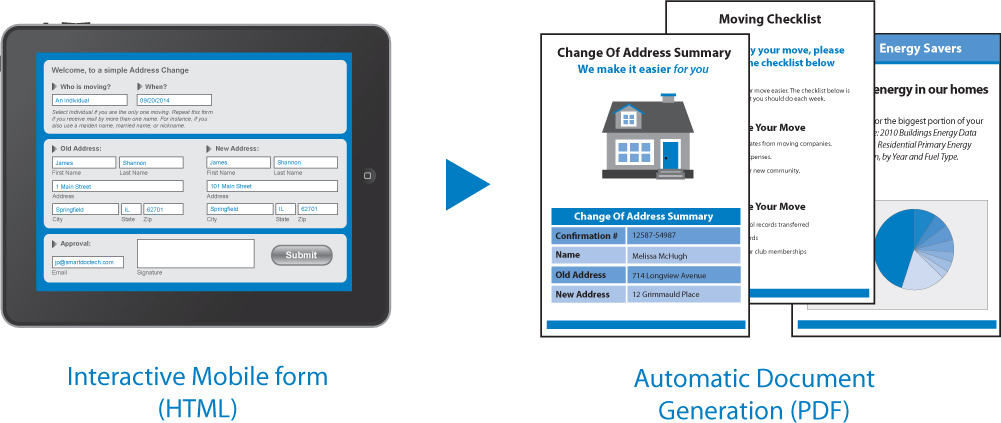
Figure I.4 The book’s companion site includes a demo of an automated Address Change workflow that includes an interactive form and dynamic document generation.
What This Book Covers
You’ll learn what Designer is, how you can use it to create PDF and HTML forms, and why this is important for your organization.
The Designer Tool
Part 1 is a thoroughly updated version of the first edition of this book. As in the first edition, this section covers the tools and features of Designer. However, it also includes the new features of Designer like style sheets and has additional advanced scripting techniques that were not part of the first edition. Part 1 ends with a comprehensive step-by-step exercise where you can put your new knowledge to the test. You’ll create a complete interactive and dynamic form from scratch.
PDF Forms
Part 2 focuses specifically on PDF forms, documents, and best practices. You’ll learn about the various types of PDFs and the different readers that people use to view them. Chapter 4 includes important information about the differences between Adobe Acrobat and the free Adobe Reader and shows you how to Reader extend your files to overcome the limits of the free version. Chapter 5 covers best practices, including form fragments, localization, accessibility, and performance optimization.
HTML Forms
Part 3 covers Designer’s new HTML capabilities and details the similarities and differences between Designer’s HTML and PDF forms. You’ll learn how to iron out some of the differences so you can develop Designer forms that can be used to render whichever form type is needed in your workflow. Like Part 1, this part ends with step-by-step exercises where you’ll create interactive and dynamic forms. However, this time they’ll be HTML forms.
Automating Business
The last part of the book shows how your Designer forms and documents will be used to automate your business. You’ll learn about Adobe’s other LiveCycle tools and modules and how they can be used to manage your forms and streamline your workflows. The last chapter of the book covers the new world of mobile forms and compares and contrasts different strategies for competing in this world.
What You Need to Begin
As mentioned, there are many hands-on exercises in this book. Therefore, you’ll need the following items to enhance your learning experience.
The Software
You need both LiveCycle Designer and Adobe Acrobat installed on your computer. You’ll develop your forms and documents in Designer and preview them with Acrobat. You’ll also need a relatively new web browser to view your forms as HTML. Chapter 6 includes a list of supported web browsers.
LiveCycle Designer
You need the Designer program. You may already have it if either of the following is true:
![]() Your company has a license for Adobe LiveCycle Enterprise Suite.
Your company has a license for Adobe LiveCycle Enterprise Suite.
![]() You have a version of Adobe Acrobat earlier than 11. Designer shipped with earlier versions of Acrobat, but beginning with Acrobat 11, Designer is sold as a separate product on the Adobe website. Please note that the versions of Designer that shipped with Acrobat prior to Acrobat 11 do not fully support the HTML capabilities described in this book. If you want to develop HTML forms, you must have Designer ES4 (version 11) or later.
You have a version of Adobe Acrobat earlier than 11. Designer shipped with earlier versions of Acrobat, but beginning with Acrobat 11, Designer is sold as a separate product on the Adobe website. Please note that the versions of Designer that shipped with Acrobat prior to Acrobat 11 do not fully support the HTML capabilities described in this book. If you want to develop HTML forms, you must have Designer ES4 (version 11) or later.
If you don’t have LiveCycle Designer, you can either buy it or download a trial version from www.adobe.com. As of this writing, Adobe is offering a 60-day free trial at www.adobe.com/products/livecycle/tools/designer.html.
If this link gets changed, simply do a Google search for LiveCycle Designer trial download. You’ll need an Adobe ID, and you can select your language version prior to downloading (Figure I.5).
There are various ways to configure your LiveCycle Designer workspace. To easily follow the exercises in this book, open the following palettes in your Designer workspace. If you don’t see any of the palettes listed, you can open them from Designer’s Window menu.
![]() The Script Editor palette
The Script Editor palette
![]() The Hierarchy palette
The Hierarchy palette
![]() The Data View palette
The Data View palette
![]() The Tab Order palette
The Tab Order palette
![]() The Object and Fragment Library palettes
The Object and Fragment Library palettes
![]() The Style Catalog palette
The Style Catalog palette
![]() The Layout, Border, Object, and Accessibility palettes
The Layout, Border, Object, and Accessibility palettes
![]() The Font and Paragraph palettes
The Font and Paragraph palettes
Adobe Acrobat
In addition to previewing your Designer forms, you’ll need Acrobat for some of the exercises in Part 2, “PDF Forms.” If you don’t have Acrobat, you can either buy it or download a free trial version from www.adobe.com.
The Companion Site

Throughout the book, you’ll see this globe icon next to a topic with more information on the book’s companion site: www.smartdoctech.com/support.
You’ll find support materials on this site, including the following:
![]() Additional bonus articles and exercises for LiveCycle Designer.
Additional bonus articles and exercises for LiveCycle Designer.
![]() Links to important information in the Adobe Help System, Knowledge Base, and Developer Connection.
Links to important information in the Adobe Help System, Knowledge Base, and Developer Connection.
![]() FAQ (Frequently Asked Questions) about the book.
FAQ (Frequently Asked Questions) about the book.
![]() Errata: The exercises in this book have been reviewed many times by several technical editors. However, as with all human endeavors, it’s possible that something is incorrect. If you find an incompatibility with one of the sample files, please report it to [email protected].
Errata: The exercises in this book have been reviewed many times by several technical editors. However, as with all human endeavors, it’s possible that something is incorrect. If you find an incompatibility with one of the sample files, please report it to [email protected].
The Sample Files

You can also download the sample files from the book’s companion site. You need these files to work through the hands-on exercises in this book.
Moving On
Now that you know what to expect, let’s get started by learning the features and functions of Adobe LiveCycle Designer.

